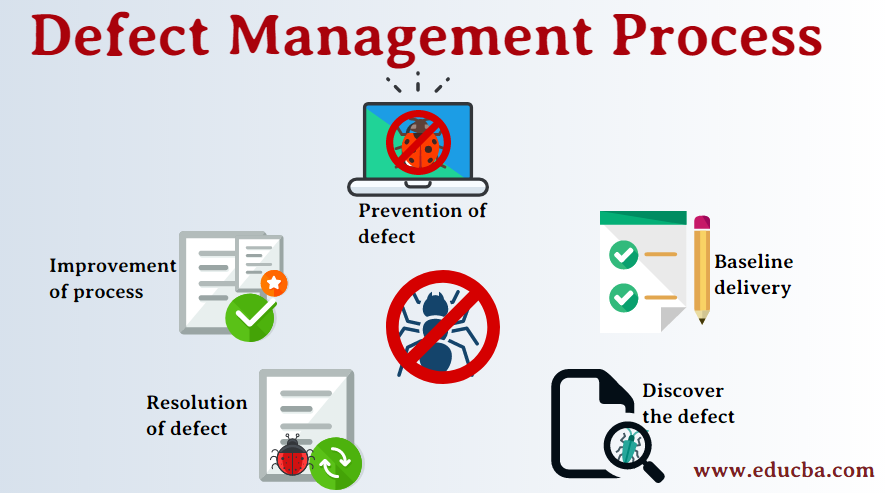
Overview of Defect Management Process
We are aware of any software written code, defects need to be checked. In the process of testing, the Defect Management Process is crucial. The defect management term is often used in software testing. The process of defect management involves detecting bugs in software and to fix them.
When a tester tests a piece of code, he comes across variations in expected output to the current output, this is termed as a defect. An alternative to defect, the term “bug”, “issues”, “incidents” are used.
Defect Report
The software tester should mention all the below mandatory fields for any defect report.
1) Unique defect ID: This is to ide0ntify the defect using a unique number.
2) Detailed description: The description must contain detailed information about the software bug. Which function was the bug found? Along with a screenshot for better understanding.
3) Report date: The defect report should contain the date and time of reporting a bug.
4) Severity: The severity of the bug, low medium, or high.
5) Fix by date: The time and date of closure of the defect.
6) Defect Raised by name: The name of a tester who raised the issue.
7) Defect fixed by developer name: The name of the developer who fixed the issue.
Defect Management Life Cycle
The verbal communication between the tester and developers will not be appropriate when the defects get increased. In order to control and handle defects, there is a need for the defect management life cycle.
There are five stages in the defect management process:
- Prevention of defect
- Baseline delivery
- Discover the defect
- Resolution to defect
- Improvement of process
Below is the detailed explanation of stages in the defect management process:
1. Prevention of defect
The defects can be prevented to an extent by following few guidelines while creating code. Also by analyzing the code, defects can be reduced. Identifying the frequent type of defect seen can be instructed to developers to avoid such a situation. The bugs cannot be 100% prevented in a practical scenario. The bugs can be reduced by a collaboration of testers and developers, which minimizes the risk.
2. Baseline delivery
A product is a baseline when a milestone completes. That is when a developer completes the milestone and sends it to a tester for testing. Stage by stage the development process continues as to when the milestone is met.
3. Discover the defect
Whenever the testing team finds a defect, it should be informed to the developer immediately. When the developer accepts the defect by the tester and acknowledges it, a defect is discovered. A tester should make sure they have found a valid defect.
4. Resolution of defect
Whenever the testing team finds a defect, and find it to be a valid one, but the developer finds the same bug to be an invalid one. An immediate resolution process needs to be actioned. The two actions can be taken in this situation. Either a Senior manager can resolve this or a Product owner can decide whether it is a defect or not.
5. Improvement of process
- In defect management, the process can be improved by using a few automated tools, which can detect the bugs in the software. There are many defect management tools available. Depending on the tools used, the developer can find a defect and correct it. Finding a defect in an earlier stage will help to prevent the big bug, which might take more time, and also focus on re-do work. Hence, this is a software cost. This cost can be reduced to fixing the bugs at the earliest stage of development. The tool will allow the notification to be sent on the particular bug and also to spot the developer to correct it.
- Managing the defect can be complex during high volume and severity. The defect management tools provide a document that will be helpful for any developer to work on it efficiently. You can categorize the defects based on priority and work on them. Once the defects are found and fixed, the developer should place back and re-run the process, as to check if all is working fine. Once the issue has been closed, it has to be updated in the report. The product quality can be improved in this process by using the right tool.
- In Agile methodologies, defect management is a bit different than others. In Agile management, it uses a particular methodology for a waterfall model. Another project methodology such as the lean methodology strives for providing zero defects in a process. The whole process of defect management is to provide a process improvement. And the process for defecting such errors is to improve the development field. This, in turn, gives a quality product to the customer, leading to high customer satisfaction.
Conclusion
Choosing the right tool will reduce the defects in any process. When a bug is found, intimating it immediately to check and fix it will make the process efficient. For any continuous process improvement, defect detection plays a very important role. In other words, Defect detection is a measure of process improvements. Any verified code must meet the quality and retain the standards.
Recommended Articles
This has been a guide to Defect Management Process. Here we discuss the overview, defect reports and defect management life cycle. You can also go through our other suggested articles to learn more –
